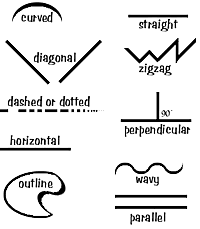There are many
different kinds of lines. Here are some common lines:

Principals and Fundamentals
of Art
http://www.sanford-artedventures.com/study/g_variety.html
Aesthetic qualities
-
The Literal Qualities
-
The Design Qualities
-
Expressive Qualities
An art work which emphasizes making the subject matter look REAL,
we call it Imitationalism. This is the theory of art which says that literal
qualities are the most important.
When the elements and principles of art are most important
in a work of art, we say that that work is an example of Formalism.
When the expression of strong emotions, moods or ideas is
the most important aspect of a work of art, we say that it is an example of
emotionalism and we speak of the expressive qualities.
Four steps of Art Criticism:
Description, Analysis,
Interpretation and Judgement.
Description
-- Can you identify the objects in the artwork?
How many people/objects are in the artwork?
What are they doing? Simply, what do you see in the work.
Collect the facts and clues only. Describe
everything you see.
Analysis
-- What elements do you think dominate the work? How is the work arranged?
Interpretation -- Based on the clues that you collected in your description, what do
you think this painting or sculpture is about? Explain what ideas, moods,
emotions, stories you think the artwork communicates.
Judgement
-- Do you think that this work is successful, and why? What kinds of
reasons can you give for your idea of why this is a good or bad art work?
Glossary
Term: Elements of Art
The elements of art are the parts of an artwork that an artist plans. The
elements are color, value, line, shape, form, texture and space.
Color:
Color (hue) is one of the
elements of Art. Artists use color
in many different ways. The colors
we see are lightwaves absorbed or reflected by everything around us. In nature,
a rainbow is white light that is broken apart by the moisture in the air.
People discovered that white light can be broken apart using tools like
prisms or this spectroscope. The
colors of the visible light spectrum are red, orange, yellow, green, blue,
indigo and violet.
White light consists of all of the colors
mixed together. The color of an object depends on how it absorbs and/or reflects
light. If an object absorbs all of the light wavelengths, it will appear black.
If it reflects all of them, it will appear white. If an object absorbs all
wavelengths except red, for example, it will look red.
Artists have invented many different media
that imitate the colors of light. Painters, for example, use powdered pigments
to reproduce the colors of the rainbow.
Value:
Value is the lightness or
darkness of a color. You can get different values of a color by mixing its
shades and tints.
Line:
You
can find lines everywhere you look.
|
There are many
different kinds of lines. Here are some common lines: |
|
By joining lines together you can make shapes
and indicate texture.
Shape: When lines meet, shapes are formed. Shapes are flat. Some shapes are
geometric, such as squares, circles, triangles, rectangles, and ovals. Other
shapes are organic or irregular.
Form: three-dimensional—they have height, width and thickness. Shapes are
flat; forms are not.
Texture:
the way something feels when you touch it. Artists also create the illusion of
texture in artworks such as paintings, drawings and prints
Space: empty place or surface in or around a work of art. Space can be
two-dimensional, three-dimensional, negative and/or positive.
Principals of Art
Balance:
how artists to create visual weight.
Artists think about how to make their works balanced by using elements
such as lines, shape and color. There are several ways to balance an artwork:
Radial balance
means lines or shapes grow from a center point.
Asymmetrical
(informal)
balance means each side of an imaginary line are different yet equal.
Symmetrial
(formal)
balance means both sides of an imaginary line are the same.
Contrast:
Two things that are very different have a lot of contrast. White
and black have the greatest contrast. Complementary also have high contrast.
Artists use high contrast to make something show up.
Proportion:
describes the size, location or amount of one thing compared to another.
Pattern:
Artists create pattern by repeating a line, shape or color over and over
again.
Rhythm: Visual
rhythm makes you think of the rhythms you hear in music or dance. Artists create
visual rhythm by repeating art elements and creating patterns.
Emphasis:
Artists use emphasis to make certain parts of their artwork stand out and
grab your attention. The center of interest or focal point is the place the
artist draws your eye to first.
Unity: The feeling that everything
in the work of art works together and looks like it fits.
Variety:
Variety occurs when an artist creates something that looks different from
the rest of the artwork. An artist may use variety to make you look at a certain
part or make the artwork more interesting.